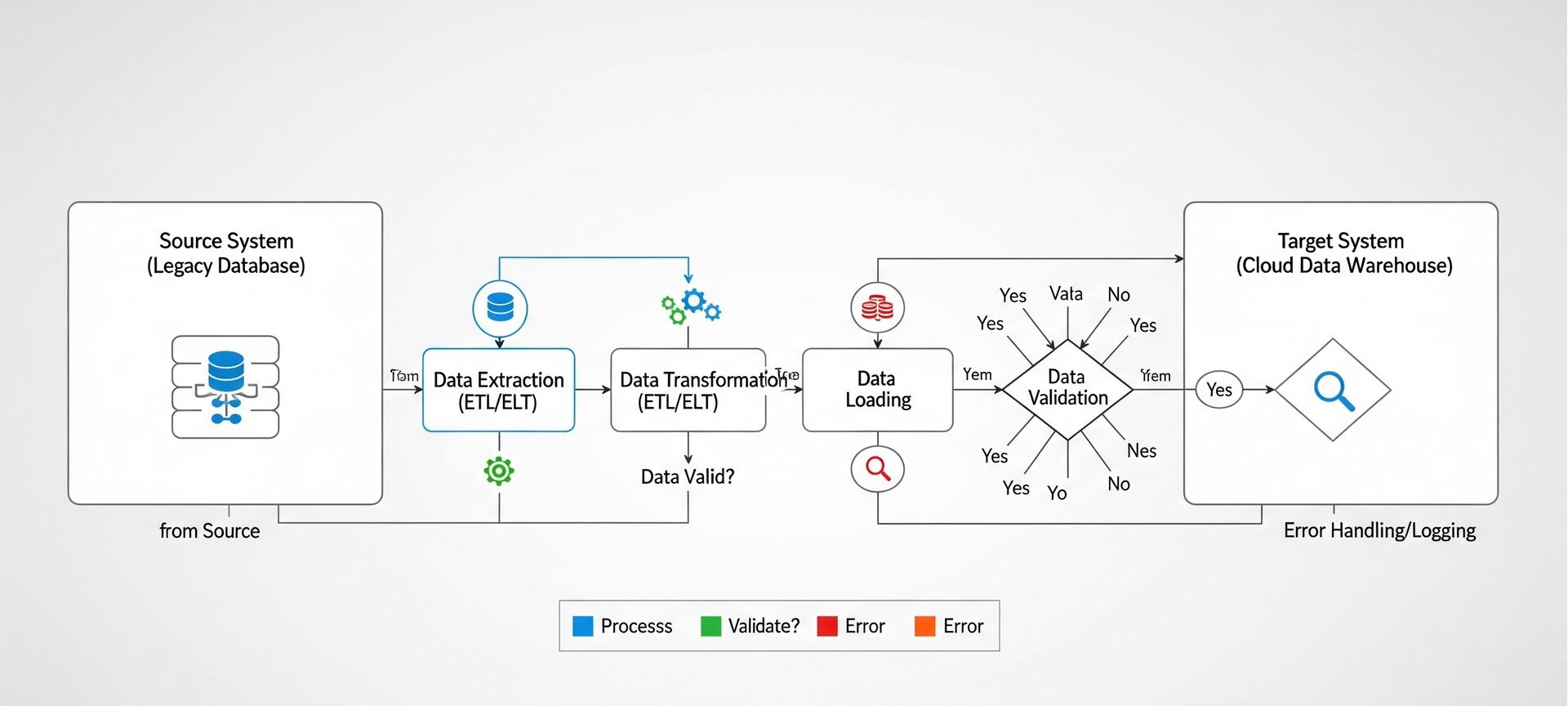Why Data Migration Is Important to Transform Your Business?
- October 10, 2025
- Posted by: admin
- Category: Uncategorized

Data is the backbone of modern business operations. Enterprises rely on data for real-time analytics that help to drive crucial decisions. But there is a million-dollar question that is often overlooked by industry leaders – Is your business relying on data that is actually stored in the right place and accurately structured for today’s demands? That’s where DATA MIGRATION slides in. For the organizations that are aiming for scalability, performance, or digital transformation, data migration is not another item for your IT to-do list; it’s mission-critical.
But before diving deeper, let’s be clear about the basics, or specifically, what data migration is. Investing 9 minutes in reading this blog, you will be crystal clear about the definition, importance, frameworks, cloud adoption, challenges, and the transformative power of data migration in today’s business landscape.
What Does Data Migration Really Mean?
If you are searching for ‘what is data migration’ in theoretical terms, then data migration means moving data from one system A to system B. But in practice? Data migration means you are handling terabytes, sometimes petabytes, of complex, interrelated, and sensitive information. It includes cleansing bad data, transforming legacy formats, validating integrity, and mapping everything in a way that actually supports your workflows on the new platform.
Hence, when we say that data migration means moving data, it’s not just relocation; it’s a full-on modernization project with real consequences like integration break, data loss, etc., if you get lazy or underestimate it. And if you got it right, then high-quality, unified data that fuels transformation is your ultimate bonus.
It’s also important to be clear about what migrations are in the technical world. Migration includes moving apps, databases, management systems, or even entire infrastructures. Data migration, though, is very specifically about getting your information from legacy systems into modern, often cloud-based environments, with all the format conversions and validations that entail.
Why Data Migration Matters to Fuel Your Business?
If organizations truly want to innovate, then they have to get their data act together first. And data migration is the backbone of the process. Here are the benefits of data migration, or say why it matters:
- Enhanced decision-making: Accurate, up-to-date data is crucial for informed decision-making. Migration consolidates that information, streamlining access and supporting quick, reliable operations across all business departments.
- Customer-centric operations: Unified customer records pave the path for personalized interactions, whether online or in-person.
- Operational resilience: Clinging to legacy systems is risky. Systems get fragile, support gets expensive, and security holes get wider with every passing quarter. Migration allows organizations to modernize their operations, ensuring reliability and reducing exposure to security threats.
Delaying the migration process can increase maintenance costs, compound inefficiency, and inevitably magnify security vulnerabilities. Competitors running on modern platforms gain a speed and agility advantage that older systems just can’t match. For a clear picture, let’s take an example of a jewelry brand that hasn’t synchronized its in-store and online data. This results in mismatched inventory, frustrating customers, and diluting brand loyalty. Migration fixes this by bridging platforms and enabling data to work holistically.
The Blueprint: Data Migration Frameworks

Data migration is a complex project that requires more than just a simple checklist. It demands a structured framework designed for risk management and alignment with business goals. Technically, a robust data migration framework follows these phases:
- Discovery and planning: Identify all the data sources, dependencies, and target environments, and set a clear migration goal.
- Data profiling and cleansing: Analyze current datasets, fix inconsistencies, and eliminate duplicates. Migrating bad data is like pouring sludge into a brand-new engine.
- Mapping and transformation: This phase demands precision as you need to ensure that your data fits the schema of the target system.
- Testing and validation: Never push your data without conducting trial or test runs. Validate timings, accuracy, and completeness before you flip the real switch.
- Deployment and monitoring: Execute the migration, but keep real-time monitoring in place. This vigilance is your safeguard against unexpected problems and compliance breaches.
These frameworks aren’t just technical formalities; they are essential risk management tools. They reduce the risk of downtime, data loss or corruption, and compliance failures with regulations like GDPR or HIPAA.
Companies that attempt a migration without a framework frequently end up dealing with major setbacks: database corruption, prolonged service outages, failed audits, etc. Whereas the organisations that adopt a structured framework finish the transition with speed and stability, ready to enjoy the full benefits of their upgraded system.
Cloud as the New Home – Data Migration in Cloud

Cloud computing is no longer just a buzzword; it has become the backbone for most modern organisations’ data migration strategy. Data migration in the cloud is now considered a key pillar of transformation. Teams are shifting their core assets, like databases, applications, high-demand workloads, and more, into cloud platforms like AWS, Microsoft Azure, or Google Cloud. A question may arise in your mind as to why migrating data to the cloud is impactful.
The reason that makes this shift impactful is the scalability and agility it offers. As your data grows, so should your resources. With the cloud, you can rest assured while scaling storage and computing power instantly. Another benefit that businesses really realize is cost optimization. Cloud helps to eliminate huge investments in physical servers. You move from massive upfront server investments to a pay-as-you-go model.
Last but not least, you get the convenience of collaboration and accessibility when you adopt cloud migration. Distributed teams can punch in and work from anywhere, with secure, real-time data at their fingertips. A practical example of it is the companies migrating customer data banks to the cloud for seamless access or shifting analytics suites upstairs to exploit cloud-native AI and machine learning services that just weren’t possible before.
Cloud migration is not just plug and play. You may face complex challenges if you miss key steps like data mapping, schema alignments, or closing security gaps. Cloud adoption without disciplined migration leads to messy data silos, exposed assets, or just plain operational chaos. The fix? Meticulous planning, steady frameworks, and a solid execution path are how you can actually harness cloud capabilities.
Common Challenges and How to Overcome Them
Data migration is a crucial part of data management, which definitely goes beyond just transferring data. Here are the key hurdles you may encounter. If you are not careful, you will run right into trouble, so it pays to recognize these risks early and have a solid migration plan.
Key Challenges of Data Migration:
1. Data Silos and Complexity
Many organisations store their data on legacy systems, on-premises servers, and third-party apps. If none of your systems even support the same data formats or API standards, you’re in for a world of pain trying to unify and map anything. The lack of system interoperability turns simple consolidation into a complex technical exercise.
2. Data Quality Issues
Migrating data with corrupted files, mismatched formats, or duplicates is like carrying forward existing problems in the new system. This makes even the best business intelligence dashboards unreliable, distorting reporting and hindering analytics.
3. Downtime and Business Disruption
Data migration involves moving data from legacy systems to a structured modern data environment, often a cloud-based platform. If you fail to minimize outages, business operations can grind to a halt, customer interactions get interrupted, and the downtime may add up to lost revenues.
4. Security Concerns
Migrating sensitive information isn’t just vulnerable; it’s a magnet for data security risks, including breaches, unauthorized access, or regulatory violations. To prevent this, it is essential to ensure robust encryption and compliance safeguards, as no one wants to deal with technical headaches. Security audits should be non-negotiable before, during, or after the move.
Each of these hurdles turns technical projects into battlefields. Addressing these challenges head-on isn’t optional; it’s mandatory if you want real digital transformation and not just chaos dressed up as progress. Now, let’s jump to the effective solutions to address these obstacles!
Strategic Solutions
1. Adopting a Robust Data Migration Framework
Never embark on the data migration process without a solid, detailed framework that establishes clear phases from planning to testing. A strong framework locks the process down, keeps timelines intact, and ensures that the data migration project actually aligns with compliance requirements.
2. Leveraging Automation and AI Tools
Automation boosts the data migration process, minimizes dependency on manual efforts, and improves data accuracy. It is effective to streamline transfer, flag errors in real time, and slash turnaround, especially when you are dealing with large datasets. Plus, no data engineer wants to be the person triple-checking for row mismatches by hand.
3. Partnering with Data Migration Experts
Migration professionals with proven experience roll in with specialized data migration tools and tested migration strategies, ensuring data integrity and security. Whether it is migrating data to the cloud, consolidating legacy systems, or meeting strict compliance mandates, their expertise makes the whole transition seamless and secure, fulfilling business needs.
Treat migration challenges as inevitable hurdles, not show-stoppers. With proper frameworks, automation, and expertise, migration becomes an opportunity to streamline systems, tighten compliance, and underpin sustainable business growth. You can trust the data migration services provided by Techmicra, which cover post-migration support that goes beyond just execution. In addition to data migration, you can also check our services, including data architecture, database administration, data warehousing solutions, AI & ML development, and more, to transform your data landscape.
Conclusion
In today’s tech world, data migration means far more than a simple process of moving data. It’s a crucial tool for driving modernization, reinforcing business continuity, and positioning companies for scalable growth. With a robust framework and cloud-first approach, you can ensure your data is accurate, accessible, and optimized for whatever digital push comes next.
Enterprises need to shift their view of data migration from an isolated IT project to an engine of transformation. Migrate smart, modernize aggressively, and keep your data horizons directly pointed at your next target. In the end, organizations that keep their data assets well-architected, accessible, and secure are the ones that will set the pace for the future!
Frequently Asked Questions
1. What exactly is data migration?
Data migration is the process of moving data from one system, storage location, or application to another. It includes data cleansing, validating, and restructuring data to ensure that it actually works well in the new environment.
2. What is an example of data migration?
For example, consider migrating customer data from an old legacy CRM to a modern cloud-based platform like AWS. It’s not just copying files; you are cleaning up the mess, mapping it so everything fits where it should, and running accuracy checks. Think of it as a deep clean and remodel for your data before it moves into its new home.
3. How important is data migration?
Data migration is crucial for seamless business operations. Accurate, secure, and accessible data lies the foundation for informed business decisions and enhanced customer experience.
4. How long does data migration take?
The time factor depends on the volume, complexity, and quality of your data. Small migrations may take a few days, whereas large-scale enterprise-level migrations involving interconnected platforms may take several months.
5. What is the difference between data migration and data transfer?
Data transfer is an easy part where data is copied or moved from one place to another. On the other hand, data migration is the process that also includes restructuring, cleansing, and validating data to ensure usability in the targeted system. Data transfer is moving boxes, and data migration is unpacking and setting up an organized new home.

